n
n
n
n

n
n
nThe character of Patrick Bateman is a character who sulks in a deeply rooted hatred of himself. He hates himself because he knows exactly the kind of shallow, empty person that he’s become and he recognizes the kind of shallow empty society he is a part of. Bateman is depicted as the epitome of the soulless Yuppie from the 80’s, the kind that had money to burn, and things to buy, buy, buy! The kind that only cares about being in tune with the height of fashion, wearing the latest trends, the most expensive brands, the best of the best.
n
n
n
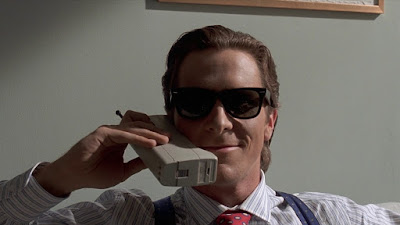
n
n
nYuppie in deed!
n
n
n
nThis fantastic character was first presented in Bret Easton Ellis’ novel ‘American Psycho’ a novel that was equal times hated and equal times revered. The book presents us with a savage portrayal of a 27 year old man who makes his living working on Wall Street in a company called Pierce and Pierce. He’s into “merger’s and acquisitions”, though when he’s hitting on girls in clubs he tells them he’s into ‘murders and mutilations’, a comment that falls on deaf ears because nobody really listens to themselves in this shallow society, they’re just going through the motions. The book is a wild satire, and when read with the right mindset can be seen as a hilarious commentary on consumerist society.
n
n
n

n
n
nBret Easton Ellis
n
n
n
nStill, there’s no denying that this is essentially a book about a guy who goes around killing innocent people because he doesn’t agree with who they are. It’s a book about a guy who hates himself and the world he lives in so much, that he simply has to murder all those whom he considers a detriment to society. And when he kills people, the descriptions in the book are truly awful. I mean this guy really goes down on his chosen victims. Perhaps you’ve seen the film and know a bit of what I’m talking about, but the book is so much more graphic then the film ever was. There are certain differences from book to film; for example, in the film Bateman’s apartment is squeaky clean, in the book his apartment is filled with human parts all over the place, bodies decaying, blood splattered on the walls…on the film they minimized this in favor of augmenting the characters obsessive cleanliness. We do see a severed head inside of his refrigerator, and he does have a couple of bodies decaying at Paul Allen’s apartment, but it’s not like in the book where it’s Bateman’s apartment that is the center of all the mayhem. In fact, in the book he has an extra apartment in Hell’s Kitchen where he decomposes bodies in acid. I did like how in the film Bateman mentions the Hell’s Kitchen apartment, though it is never shown on the film, it kind of let us know that the filmmakers knew the book very well, they just couldn’t film everything.
n
n
n
n
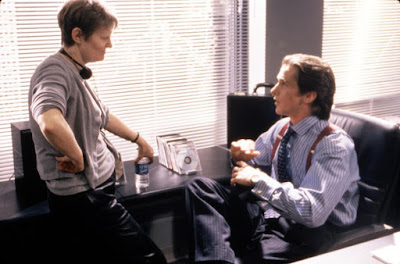
n
n
nDirector Mary Harron and Christian Bale talk out a scene
n
n
n
nIn fact, fans of the book might get a kick at how even though the film doesn’t show ever single situation and murder committed in the book, at the very least they are referenced and alluded to all through out the film. For example in one scene Bateman mentions that he killed “some old fagot with a dog” which is one of the more graphic and controversial deaths in the book. When Jean, Bateman’s receptionist finds a notebook that Bateman scribbles and doodles on, if you freeze frame those scenes, you can see that the doodles Bateman’s made on his little notebook are doodles of the murders that actually happen in the book, but we don’t see on film. Obviously they were too horrible to appear in the film, and I get that. It’s true, some of the murders described in the book are way too graphic and over the top. After all, we are talking about a novel that’s been banned in many countries, never sold to anyone under 18 in others, and sold only in shrink wrap in others! I don’t blame the people of Germany for considering this book to be “harmful to minors”; this my friends is a truly violent book!
n
n
n
n
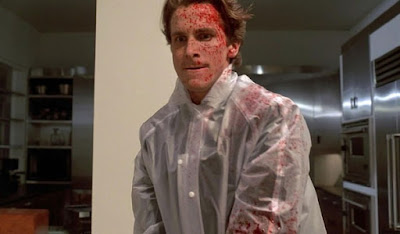
n
n
nBut were not talking about a simple slasher film here that makes heroes out of the bad guys, this is a film that means to comment on real issues dealing with the world were living in. The book and the film never show Bateman’s behavior as being good or positive or as something to emulate or admire; in fact, it is made quite clear that he is loosing it, that he is psychotic and dangerous to society and to himself, bottom line is, this is not a happy man. On more than one occasion the character actually recognizes his psychotic behavior. During a pivotal scene of the film he admits to his lawyer that he is a “pretty sick guy”, and during another scene he tells someone “I like to dissect girls. Did you know I’m utterly insane?” Bateman actually recognizes the fact that he is going insane, but it’s as if he could do nothing to stop it from happening. So it’s not like the film is making Bateman into some sort of a hero. What he is in my opinion, is a victim of the world he lives in. Society has created a monster, it’s driven him insane with its blatant consumerism, the racism that he’s been brought up in and the superficiality of society; the importance given to physical beauty as opposed to internal beauty and countless other things that make up the world we live in. Patrick Bateman -the monster- is loose on the streets of Manhattan and it wants payback for what he’s been turned into! Another way to look at this character is that he is judging society for what it has become. This is the kind of film where we don’t side with the protagonist; what we’re meant to do is watch him degenerate and descend into madness and then learn from the reasons that sent him there.
n
n
n
n
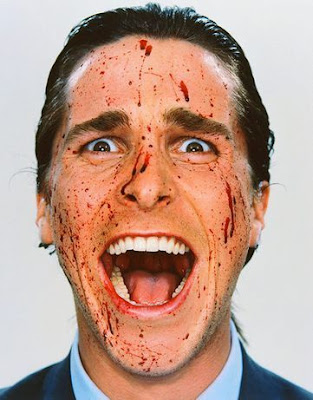
n
n
nGoing utterly insane!
n
n
n
nVarious things drive Bateman insane, among them his intense hatred for homosexuals. Though this was ignored in the film, he murders an old gay guy who starts hitting on him while walking through Central Park. By the way, Bateman also kills the old mans dog by strangling it to death. Maybe Bateman would be happier if he’d been taught to co-exist with different kinds of people? He is also portrayed as a hippy hater, always considering them to be less than him, the less fortunate are that way because they want to be, he has no sympathy at all for others. He makes fun of other ethnicity’s when he considers them lower than him. One moment in the book has Bateman going into a club and making fun of a group of black people by trying to talk the way he thinks they talk; it’s safe to say that part of Batemans unhappiness comes from his blatant racism. Bateman hates the homeless for not doing something about their lives; again, no sympathy. He hates how fake his co-workers are. They never call him by his real name, a common theme through out both the book and the movie. This is the kind of world in which people don’t really know people, so they never really know each others names! They keep confusing each other with other people, which gels perfectly well with the fact that Bateman feels he has no actual distinguishable personality. He knows Huey Lewis and the News entire discography, he knows everything about Genesis and Whitney Houston (whole chapters of the book are dedicated to this knowledge) but he doesn’t know himself, he doesn’t know who he is. He is physically fit, but not emotionally or psychologically mature.
n
n
n
n
n
n
n
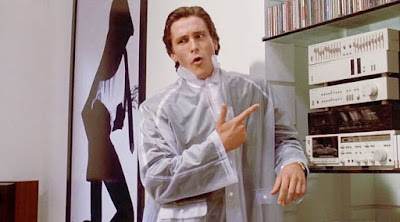
n
nBateman tries finding love in his life, but all he can achieve is sex, and he manages to turn even that into a sick and twisted affair of the most aberrant kind. In the film Batemans sexual encounters are not as graphic because again: what’s described in the book is way to visceral to film. Same as the violence, the sexual situations described in the book are totally out there and described in detail. Bateman actually ends up having sex with a dismembered head if you can believe it! The sexual elements are so strong in the book, that the filmmakers had to edit 18 seconds out of a scene involving a threesome just so it could get an ‘R’ rating instead of an ‘NC-17’; if they had actually filmed the sexual situations seen in the book, the film would have never seen the light of day. Reading those sequences was like watching a sick twisted porn flick where all those involved get dismembered in the end. Hell, in the novel Bateman actually eats some of his victims! This is yet another big difference between the film and the book. In the film they only allude to Batemans cannibalism, while on the book it is described in splendid detail.
n
n
n
n

n
n
n
n
n
n
nWhat would this film be without Christian Bale? I mean, I don’t think a better actor could have been chosen. Do you think Di Caprio could have pulled this film off with as much vulnerability and rage and insanity as Bale did? I seriously doubt it, but Di Caprio was considered for the role. What’s great about Bales performance is that he really goes nuts in some scenes, my personal favorite is the one where he does his phone confession, he really talks and acts as if he was crazy. He also plays it with this sense of comedy, you kind of get the feeling that Bateman is actually making fun of people through out his life, mocking them, which in my opinion he is. Aside from Batemans stone cold performance, we have Willem Defoe playing a New York detective who has a hunch that Bateman might be the one behind all the killings. Dafoe’s character was expanded for the film, he isn’t in the book as much. Chloe Sevigny plays Batemans innocent and naïve receptionist, she is so in love with Bateman that she doesn’t even see his dark side or she chooses to ignore it. The whole cast of young actors that make up Batemans body of co-workers is fantastic as well: Jared Leto, Justin Theroux, Josh Lucas, all great in my book. They really captured that fake superficial lifestyle and attitude. Reese Witherspoon plays the gloriously ditzy air head of a girlfriend that Bateman has. She ignores that their relationship is non existent and instead chooses to plan their wedding.
n
n
n
n
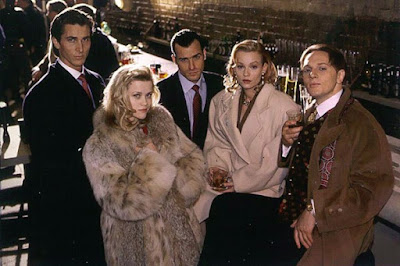
n
n
n
n
nAll in all, I’d say the film captures very well the essence of the book. Though it does leave a lot of things out, it is completely understandable considering just how graphic the book can be. I mean, one moment in the book has Bateman actually capturing a kid in a zoo and killing him in the shadows! He later accepts that there is no joy in killing a child because the child has no history or life experiences to extinguish, which is the pleasure he gets from killing adults. But damn, even I say that moment was a bit too much! So the film is basically a more “controlled” version of the book that manages to say what the book has to say as well, it comments on the same issues, but it does so in a slightly more constrained manner. Still, the movie does have its extremely bloody, violent and sexual moments, just not as graphic as in Ellis’ novel. Director Mary Harron delivered a stylish and slick looking film, appropriately cold looking. She squeezed out a magnificent performance from Bale! And kudos to Harron, this is a woman directing a film about a guy who treats woman with complete disdain; it took guts for a woman to make this film. I also applaud Easton Ellis for writing such a great yet misunderstood book, the themes and issues commented on the book needed to be addressed and Ellis was not afraid to do it; here’s a writer with some true guts to say what has to be said about the kind of society we’ve turned into. Can we look at our collective fractured psyches and fix things up a bit?
n
n
n
nRating for the Book: 5 out of 5
n
nRating for the Film: 5 out of 5
n
n
n
n
n
n
n
n
n
n

n
n































